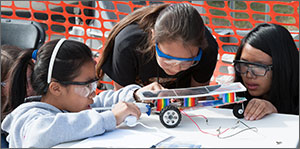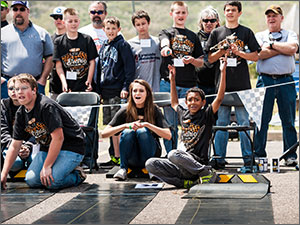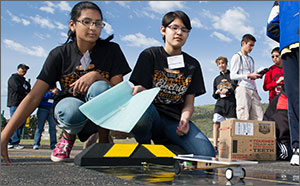Model Car Races Put Creativity on the Line
 Enlarge image
Enlarge image
Students make last-minute adjustments to their vehicles as they compete in NREL's 24th Solar and Lithium-Ion Battery car competitions held at Dakota Ridge High School in Littleton, Colorado. Photo by Dennis Schroeder, NREL
Emotions ran the gamut at the recent middle-school solar and lithium-ion car races hosted by the Energy Department's National Renewable Energy Laboratory (NREL). Nervous tension was heightened as the sun played an ornery game of peekaboo with the threatening rain clouds. The students' anxiety then gave way to grins of excitement—or grimaces of dismay—as their solar and lithium-ion battery cars raced (or crept) to the finish line.
"It was so stressful for me," Cullen Gillum of Lincoln Academy said. "If I don't catch the car at the finish line, it smashes—but I do have the magic touch."
This was the 24th year of the Junior Solar Sprint and Lithium-Ion Battery car competitions for Colorado's middle schoolers. Nearly 300 students on 74 teams from 21 Colorado schools were at Dakota Ridge High School in Littleton, Colorado, to vie for a spot in the final races. The middle schoolers raced solar and lithium-ion battery powered vehicles they designed and built themselves.
Each year, the Energy Department, NREL, and other local sponsors host the races to show middle-school students that science, engineering, and design can be rewarding—and to encourage them toward careers in STEM: science, technology, engineering, and math.
Linda Lung, NREL's Education Programs Coordinator, notes that teams often start competing in the sixth grade, and by the time the students are in the eighth grade they have learned the engineering principles to design and build a fast clean-energy model car.
"The car competition challenges students to use scientific know-how, creative thinking, experimentation, and teamwork to design and build high-performance model solar and lithium-ion battery vehicles," Lung said.
The batteries used in the lithium-ion competition are supplied by the Energy Department, and teams in the solar competition purchase authorized solar panels. Then, they design and build the rest of their cars themselves. Solar and lithium-ion battery power are highlighted at the competition because they are important research focuses for NREL and the Energy Department.
"This is a great learning experience coupled with a challenging engineering task," NREL's Associate Laboratory Director for Innovation, Partnering, and Outreach Bill Farris said. "The clean-energy future will need the attention of the next generation of scientists and engineers. This competition helps them get engaged in the energy challenges that lie ahead."
Small School, Big Win
 Enlarge image
Enlarge image
William Roberts E-8 students Sadie Havens and Omar Sene celebrate a victory at NREL's 24th Solar and Lithium-Ion Battery car competitions. The team won a trophy for the fastest lithium-ion powered car with a winning time of 5.58 seconds.Photo by Dennis Schroeder, NREL
The sun's rays were in limited supply for the Junior Solar Sprint, forcing race judges to watch the rain clouds move on through and then be ready to start the moment the sun reappeared. But the students took it all in stride, focusing instead on the design of their cars.
"We went for lightweight and aerodynamic," Matthew Heitmann with the "Green Team" from Calhan Middle School said. Calhan is a smaller school from the eastern plains of Colorado, and its team's excitement was contagious when their car covered the track in a zippy 5.17 seconds for the first-place win.
While speed is important, the judges also recognize good design, and in the solar car competition the first-place design award went to Woodlands Academy and their car "Ring Ding the Fox."
For some teams, getting the design right meant starting from scratch.
"We started building, and it was really fun, but we did mess up the first time," Claire Stufflebeam of Ken Caryl Middle School said. "We had to start over, but it was a really good learning experience."
"We copied our design from a dragster, but we measured it out and made it even so there was no tilt to the solar panels," The Manning School's Diana Santos said. "We learned about the solar panel and how it has silicon that helps collect the sun rays, and when the sun shines on the panel, the motor can use the energy."
Even the fastest car on the track gave its team some headaches. "We destroyed one of our motors, so we learned to be more careful," Heitmann said. "And to make sure your wheels are on tight—ours came off twice."
First-Time Team Brings Fastest Battery Car
 Enlarge image
Enlarge image
Eshita Mittal and Diana Santos from The Manning School uncover their solar racecar
for the start of the race.
Photo by Dennis Schroeder, NREL
While clouds blocking the sun raised the level of tension for the solar racers, it didn't matter to the students racing lithium-ion battery cars. What mattered most to the students from William Roberts E-8 School was getting a good feel for the competition.
"We're here as part of our enrichment program to offer neat activities outside of the classroom," said Assistant Principal Grant Varveris. "This is our first competition—we didn't really know what to expect."
Jon Havens, the eighth-grade science teacher for William Roberts, added: "We want to focus on engineering; it's part of the Common Core and science standards. Plus, kids love competition. It's engaging, and they are having a great time out here."
Whatever the formula, the students from William Roberts had an impressive first showing. Their dinosaur-looking car "The Dinos" came in with a winning time of 5.58 seconds.
"Our framing was very precise," team member Omar Sene said. "We also have foam on the car to protect it if the salt moves so it won't break the car. We have rubber bands on the wheels for traction. And, we also learned how to wire." Each lithium-ion battery powered car is required to carry an added payload of salt. This provides the students an extra engineering challenge.
But it was actually The Manning School and its car "Manning Battery 2" that took home the trophy for winning lithium-ion battery car design. For a complete list of winners at this year's race, see the list below.
"The car competitions are a great venue for these students to get recognized for their academic accomplishments," Lund said. "These students are the next generation of engineers and scientists who will find new technological energy and transportation solutions."
The annual competition is sponsored by NREL, the Energy Department's Office of Science, the Alliance for Sustainable Energy, Jefferson County Schools, Dakota Ridge High School, and the Energy Department's Golden Service Center. Phil Long Ford of Denver, Whole Foods Market, Sam's Club, and Mahnke Auto Body supported the event by providing lunches and trophies for the winning teams.
Learn more about NREL's education programs for middle school, high school, and college internships.
— Heather Lammers
Trophy Winners at the 2014 Middle-School Electric Car Competitions
Junior Solar Sprint, Speed Competition
First Place: Calhan Middle School (Calhan), "Green Team" with a winning time of 5.17
seconds
Second Place: Bell Middle School (Golden), "Team Bell 3" with a time of 5.37 seconds
Third Place: Sabin Middle School (Colorado Springs), "SRD" with a time of 5.40 seconds
Junior Solar Sprint, Design Competition
First Place: Woodlands Academy (Castle Rock), "Ring Ding the Fox"
Second Place: Deer Creek Middle School (Littleton), "The Car"
Third Place: Bell Middle School, "Team Bell 3"
Lithium-Ion Cars, Speed Competition
First Place: William Roberts E-8 (Denver), "The Dinos" with a winning time of 5.58
seconds
Second Place: Lincoln Academy Middle School (Arvada), "Epic with Brains" with a time
of 5.98 seconds
Third Place: D'Evelyn Junior/Senior High School (Denver), "D'Evelyn Team 2" with a
time of 5.99 seconds
Lithium-Ion Cars, Design Competition
First Place: The Manning School (Jeffco), "Manning Battery 2"
Second Place: Woodlands Academy, (Castle Rock) "The Antmobile"
Third Place: D'Evelyn Junior/Senior High School, (Denver) "D'Evelyn Team 1"
The "Emmie the Swan" team from Woodlands Academy was awarded the Spirit Award for exhibiting good sportsmanship, including fairness and respectful behavior.
